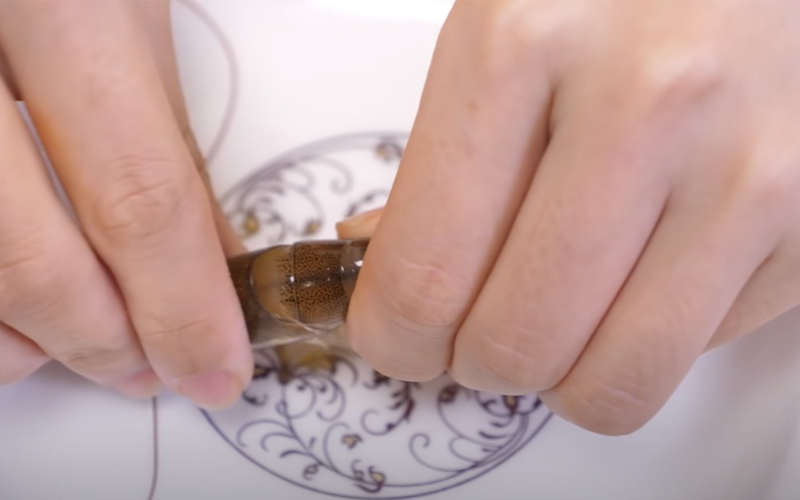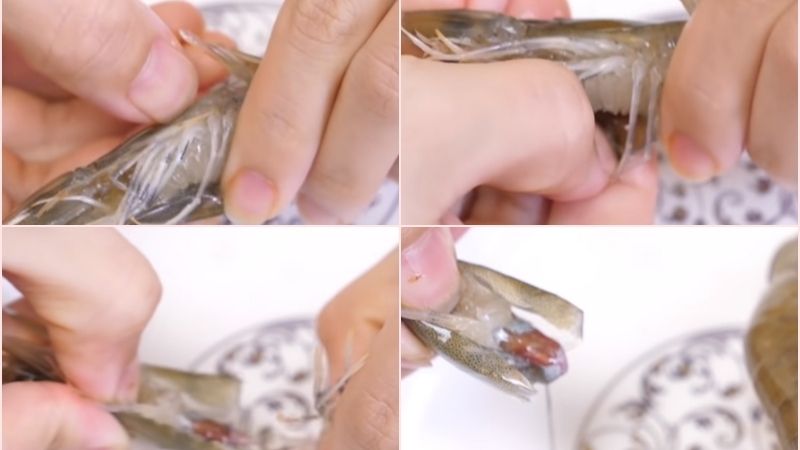There are numerous ways to devein shrimp, but having to peel them first can be quite a hassle. Below is a super quick method on how to devein shrimp in just 2 seconds each without having to peel them. Let’s dive in and master this technique!
1 Quick Shrimp Deveining
There are indeed numerous ways to devein shrimp. You could peel the shrimp completely, then make a longitudinal cut on the back to reveal and remove the vein. Or you could use a specialized shrimp deveiner. However, these methods can be a bit tedious. So, let me suggest three simpler ways to achieve the same result without any tools whatsoever.
Method 1
First, hold the shrimp with both hands so that you can see the vein. With one hand, grip the head of the shrimp, and with the other, hold the upper part of its body near the head. Make sure there’s about a 1cm distance between your grip points.
 Hold the shrimp with one hand on the head and the other near it
Hold the shrimp with one hand on the head and the other near it
Next, gently fold the shrimp’s head and gently squeeze from the bottom up to push out the waste from the head. However, don’t detach the waste completely; instead, hold it at the point where the head meets the body.
 Fold the head and squeeze gently from the bottom up
Fold the head and squeeze gently from the bottom up
Finally, pull the vein out of the body by holding the waste and slowly drawing it out. Be careful not to pull too quickly to avoid breaking the vein.
 Pull the vein out slowly
Pull the vein out slowly
Method 2
Start by laying the shrimp on its back, with one hand holding its body and the other peeling the sides of its head.
Then, hold firmly onto the point where the head meets the body and slowly detach the head from the body. As you do this, the vein, which is attached to the waste in the head, will also be pulled out.
 Hold the body and detach the head, pulling out the vein
Hold the body and detach the head, pulling out the vein
Method 3
First, use a pair of scissors or your fingers to snip off the shrimp’s head, then use a sharp, pointed object to remove any remaining entrails.
 Cut off the head and use a sharp object to remove entrails
Cut off the head and use a sharp object to remove entrails
From the top of the body to about 1 cm down, use the sharp object to press into the shrimp’s body and extract the vein.
 Use a sharp object to press into the body and remove the vein
Use a sharp object to press into the body and remove the vein
2 Why Devein Shrimp?
Shrimp have a dark vein that runs along their back, which is part of their digestive system. This vein contains waste, and while it’s not harmful to humans if consumed, it’s still better to remove it. Deveining results in cleaner shrimp and a more pleasant dining experience.
For very small shrimp, it’s best to avoid deveining to prevent them from falling apart. However, for larger shrimp, it’s worth taking the time to clean them properly.
So, with these two simple methods that require no tools or peeling, you can easily devein shrimp. No matter the quantity, you’ll be able to handle it like a pro! Good luck, and happy cooking!









